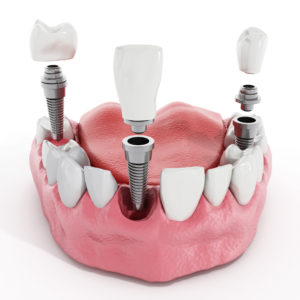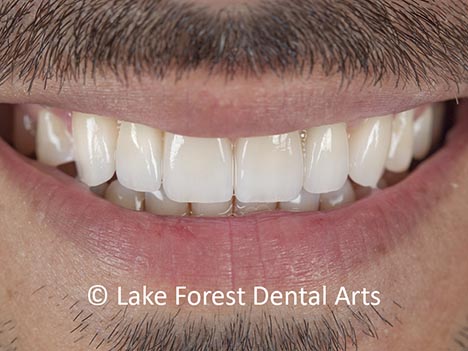
Dental implants have long been considered the most reliable and durable way to replace teeth available. These titanium posts are placed into the jawbone during an oral surgery procedure. Once a dental implant fixture has healed, it can be restored with a crown, which can be used just like a natural tooth. In this article, we’ll explain how implant crowns work and explore topics such as:
- Traditional crowns vs implant restorations
- How implant crowns are attached
- When an implant should be restored
- Different types of dental crowns
- The lifespan of a dental crown
- How to properly care for your implant crown

Two of the front six teeth in the smile are supported by implants. It is extremely difficult to tell which teeth are not natural.
Traditional Crown vs Implant Crown
Implant crowns are similar in design to crowns for natural teeth. When a traditional crown is placed, the natural tooth structure must be altered so it can become an anchor for your new restoration.
An implant crown looks and feels like a traditional crown. However, instead of being bonded to a natural tooth, it is attached to an implant.
How is a Crown Attached to an Implant?
First, it’s important to understand what the crown is being attached to. There are three parts to an implant crown: the implant itself, an abutment (or connector post), and the crown that goes on top. The abutment is the component that extends just beyond the gum line, serving as an anchor for the crown.
There are two primary ways to attach a crown to an implant: dental cement or screw retention. Both methods are successful. The type chosen for you will depend on several factors, including the implant system used, your dentist’s preferences, and the location of the implant in the mouth.
Attaching an implant crown with dental cement is no different from bonding it to a natural tooth. Screw-retained crowns are attached using tiny screws that fit down into the internal portion of the implant itself.
When Should an Implant be Restored?
The answer to this question will depend on a couple of factors: the health and density of the jawbone and the location of the implant. In order for an implant to succeed long term, it must be housed by healthy, dense bone. If the bone is weak, or if a new bone graft was placed during the procedure, your dentist will likely wait several months before placing the implant crown.
In addition, it’s important to consider the bite forces that will affect the implant. The back teeth are under far more pressure than the front teeth when chewing. For this reason, implants placed in the back of the jaw are not generally restored until at least three to six months later. However, implants placed in the front of the jaw can often be restored immediately. Several research studies – like this one conducted by Lorenzoni, Pertl, Zhang, Wimmer, and Wegscheider – found that anterior implants that were immediately loaded had a 100 percent survival rate after the first year.
If you are considering replacing a missing tooth with a dental implant, your dentist will give you a general timeline, so you know what to expect.
Types of Dental Crowns
The materials used to fabricate implant crowns are the same materials used for traditional crowns. Some of the most common include:
- All-ceramic: Chosen because of their natural color-matching capabilities, ceramic crowns are also a good option for those with metal allergies. Keep in mind that all-ceramic crowns are not as strong and may be susceptible to chipping eventually.
- Pressed ceramic: These restorations have a much harder inner core. They’re coated with porcelain, giving them a lifelike look.
- PFM: Porcelain-fused-to-metal crowns offer the strength of metal and the aesthetics of dental porcelain. These restorations have a metal substructure, which is coated with high-grade porcelain for a natural appearance.
- Zirconia: Though it looks like ceramic, zirconia is actually considered a metal. A newer option, these crowns have proven to be just as strong as gold.
Lifespan of an Implant Crown
Dental implants can last a lifetime with proper care. However, the crown on top will likely need to be replaced at some point. With the advanced dental materials available today, most crowns can last upwards of 20 or 30 years if maintained properly.
Caring for Your Dental Crown
To keep your dental restorations in tip top condition, there are a few oral health recommendations to follow:
- Brush your teeth with a soft toothbrush and a nonabrasive gel
- Floss the gum tissues around your implant at least once every day
- Avoid using your implant to open packages or bite into hard objects
- Visit your dentist regularly for exams and cleanings
Learn More about Implant Restorations
Interested in learning more about implants or the custom crowns that restore them? You can call our office to schedule an appointment at (847) 234-0517 or contact us online anytime.
